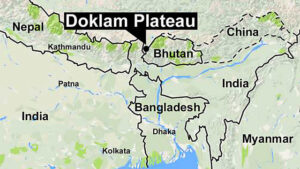 Speculation is rife in the media that World War III is about to break out due to a standoff between Chinese and Indian troops on the Doklam plateau – an area at the confluence of Tibet, Bhutan and Sikkim, it is disputed territory normally recognised as Bhutanese but claimed by China. The standoff, sparked by a Chinese road construction project which encroached upon the territory of India’s staunch ally Bhutan, has been ongoing for over two months now. Each side has roughly two hundred troops stationed in the area which stands at an altitude ranging from between 10,000 to 14,000 feet.
Speculation is rife in the media that World War III is about to break out due to a standoff between Chinese and Indian troops on the Doklam plateau – an area at the confluence of Tibet, Bhutan and Sikkim, it is disputed territory normally recognised as Bhutanese but claimed by China. The standoff, sparked by a Chinese road construction project which encroached upon the territory of India’s staunch ally Bhutan, has been ongoing for over two months now. Each side has roughly two hundred troops stationed in the area which stands at an altitude ranging from between 10,000 to 14,000 feet.
Various print and online publications have had a field day with an observation on the matter made by Hu Zhiyong, a research fellow at the Shanghai Academy of Social Sciences. Zhiyong said “China will not allow the military standoff between China and India to last too long, and there may be a small-scale operation to expel Indian troops within two weeks”. Subsequent headlines referring to Mr Zhiyong’s comments have included “Breaking: China Declares a Full-Scale India-China War very soon” in The Economic Times and “Doklam Standoff – China mulling “small scale military operation against India” on the Livemint website. The Indian Express and the UK based The Independent made the comments the centrepiece of major pieces on the issue. Despite this media frenzy, the impact of Mr Zhiyong’s thinking on official Chinese government policy, while not confirmed, is rumoured to be none. Questioned about Zhiyong’s comment, China’s Defence Ministry spokesman Sr Col Ren Guoqiang told an Indian delegation: “This kind of report represents the view of the media and think-tanks. For official information please refer to the statements of foreign ministry and defence ministry spokespersons”.
Meghnad Desai, a member of the British House of Lords and a known commentator on south Asian affairs has also thrown some scraps to the press vultures eager for war related click bait this week. Desai, who published a book entitled Hubris in 2015, confidently predicted a full-scale war between China and India “fought on multiple fronts – from the mountains of the Himalayas to the waters of the South China Sea”. The United States will back India, according to Desai, who was quoted in alarmist pieces published by The Financial Express, India Today and The Hindustan Times, among others. He did offer a word of caution to the “journalists” urgently jotting down his every utterance: “I am not a jyotisi (astrologer)”, he said.
Despite opting for an eye-catching title, Allison Fedirka offers a soberer analysis of the situation in her article for Business Insider, “China and India may be on a path to war”. This article points out that the terrain and the weather in the Doklam region are anathema to war and that it would be a logistical nightmare to supply troops there due to transportation difficulties, particularly during the rainy and winter seasons. Fedirka writes: “saying there is a potential for war because a few hundred troops are in a standoff is an over simplification of what war would actually entail”. This article also stresses that both the Chinese and Indian governments have more pressing concerns than Doklam. Modi’s government in India is trying to centralise government control and sustain economic growth whilst simultaneously dealing with the continued fallout from the demonetisation policy and the effort to move towards a cashless economy. China are in the process of transitioning from a booming manufacturing economy to a steady consumer economy. Chinese President Xi’s government is also dealing with bellicose rhetoric from US President Donald Trump regarding North Korea’s nuclear missile programme.
Away from the propaganda war playing out in the media, President Xi has made no public statements with direct relation to the Doklam issue. In a recent speech to military personnel he said: “The People’s Liberation Army has confidence and capability in defeating all invading enemies and protecting China’s national sovereignty, security and development interests”. India Today reported on this as Xi’s sly way of calling the Indian army an invading force at Doklam, but the remarks seem to be standard fare for a leader addressing their country’s military. Prime Minister Modi made passing reference to the events at the border during a speech at a conference, saying he was “confident that the solutions will be found through Asia’s oldest traditions of dialogue ad debate”. The two leaders are due to meet at a BRICS (an association of five major emerging national economies: Brazil, Russia, India, China and South Africa) summit in Beijing in September.

His Holiness the Dalai Lama speaking to Times Now editor Srinjoy Chowdhury in New Delhi
Photo: tibet.net
His Holiness the Dalai Lama, speaking to the Indian media, said, “There have been Chinese troops on the Indian border since the so-called liberation of Tibet where there were none before”. In a separate interview, speaking of China he said that the “Methods they employ give rise to fear. When there’s fear, there’s no trust and where there’s no trust how can you expect to create harmony or stability?”




 Print
Print Email
Email